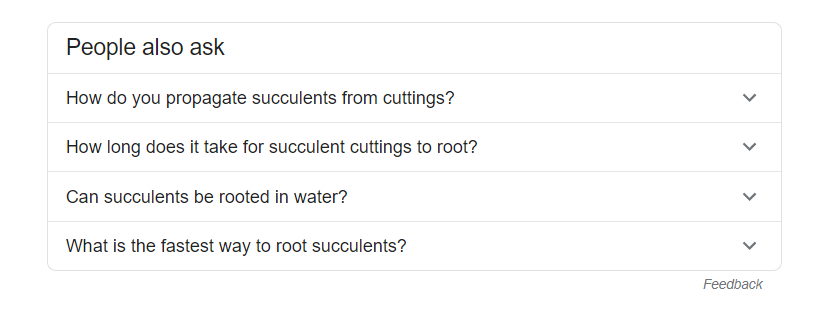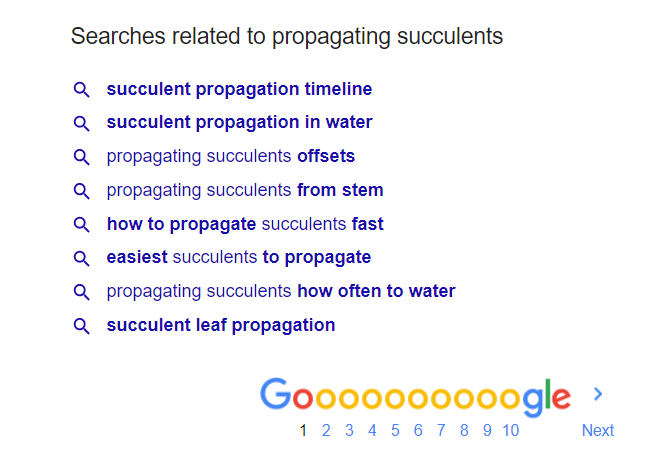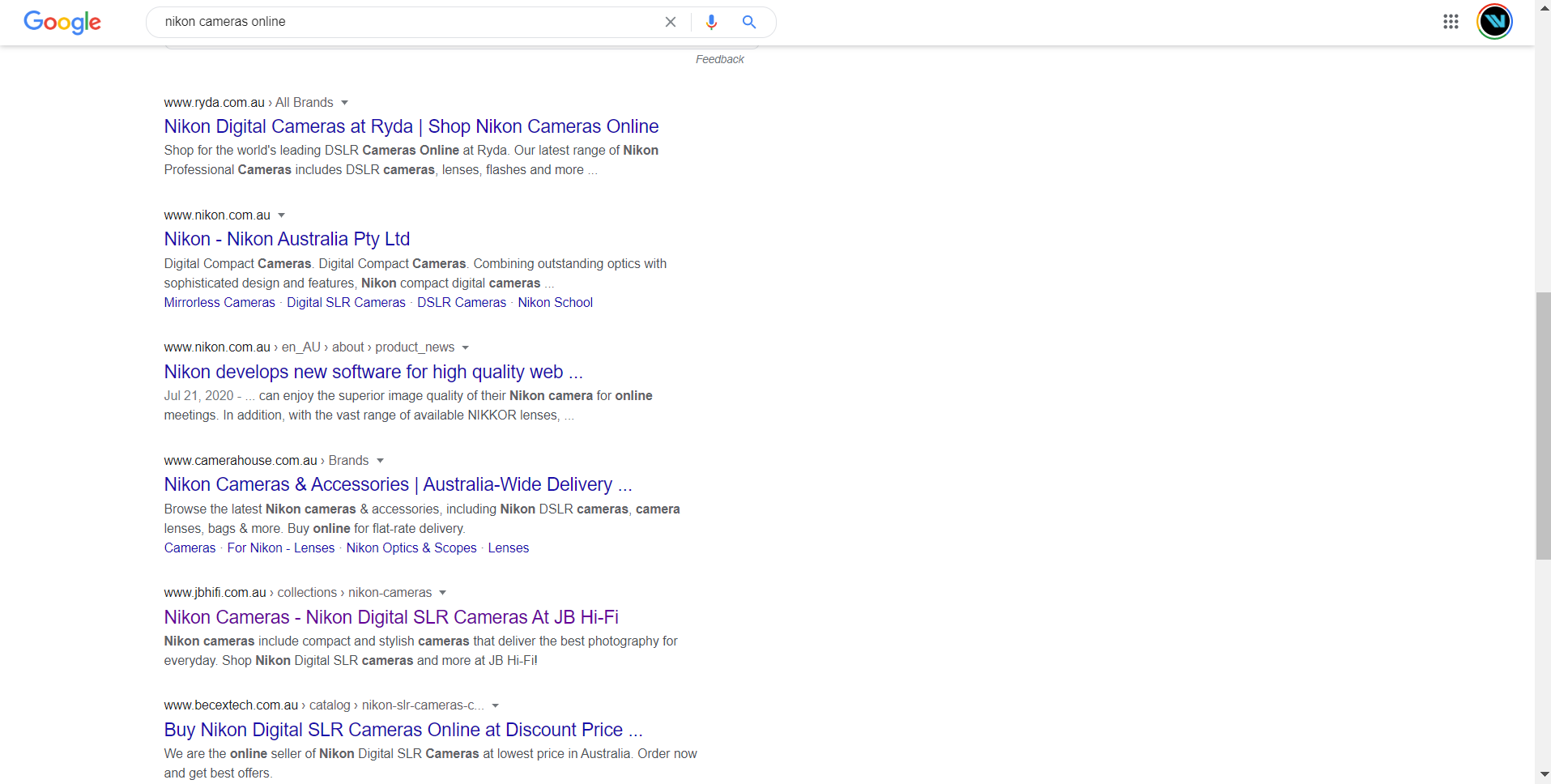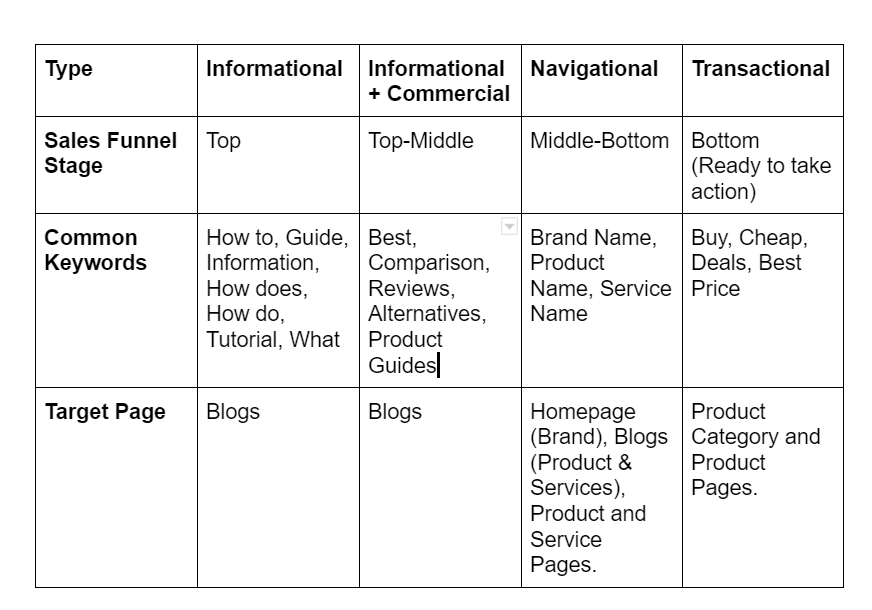 This blog introduces you to the concept of search intent, provides a breakdown of different types of search intent and gives you some actionable tips on how you can identify and optimise for the different types of search intent.
This blog introduces you to the concept of search intent, provides a breakdown of different types of search intent and gives you some actionable tips on how you can identify and optimise for the different types of search intent.
What is search intent?
Search intent is the rationale or the reason behind the search query that a user undertakes on search engines.
The user has the need to find something and in order to find that something they perform a search on a search engine using certain keywords.
What a user types into the search bar tells you about the user’s search intent.
Examples to dive further into the concept of search intent,
- Nikon DSLR Cameras Under $1000: The user here is performing a search with the intention to find information on a camera that they are planning to buy, perhaps.This search query can be broken down as informational with an intent to purchase a product.This user can be seen as being in the preliminary stage of their buying decision.
- DSLR Camera Buying Guide: This search query is seen to be as informational as the user here is looking to find information on purchasing a camera.A photography blog or a camera retailer could perhaps optimise their website to satisfy the user’s need for information and then try to convert them into a paid customer.
- Buy Cameras Online: In this case, the user can be seen as having an intent to purchase a camera, therefore, this search query can be termed as transactional in nature.
- Youtube: Here the user can be seen as utilising the search engine to navigate the web.
Why should you focus on search intent while creating content?
Well, put it simply, Google focuses on search relevance i.e. producing the most relevant results for a particular search query in order to satisfy the user. So, if you are able to answer the user’s question then you increase the chances of appearing on top of the SERP’s.
By concentrating on search intent you end up in a better position not only from an SEO point of view but also from a user experience point of view.
Here are some reasons for concentrating on search intent,
- You are providing an overall better user experience to the user, therefore, increasing the chances of a click-through and conversions.
- You work in line with the E-A-T principles as recommended by Google.
- You increase the chances of your website being shown as the featured snippet result (position zero) or “people also ask” section.
What are the different types of search intent?
- Informational Search Intent
- Navigational Search Intent
- Transactional Search Intent
Informational Search Intent
This is where a user is trying to find information about something or in other words, gain knowledge on a particular topic or simply find an answer to a question that they might have.
Informational searches can be broken down into search queries that are purely information-driven and ones that have a commercial intent attached to them.
Here are examples for both types of information-based searches,
- Sydney Weather: This is purely an information-driven search where the user is looking for weather-related information.
- The Doors LP: This can be both an information-based search with the aim of finding all the released LP’s of the group and an information-based search with commercial intent.
- How to Propagate a Succulent: An information-based search where the user is looking to learn something.
- Samsung Galaxy S5: This could be an information-based search with commercial intent attached to it
- Chocolate Cake Recipe: A purely information-based search where a user is intending to learn the recipe of a chocolate cake.
Navigational Search Intent
The second type of search intent is where the user is typing in a brand name in the search engines in order to navigate their way through the web.
For example, the user types in YouTube or Spotify to simply go to YouTube rather than having to type in the web address in their browser. This is a brand-related search.
Navigational keywords can also encompass product names, service names.
Transactional Search Intent
The third type of search intent is when the user knows exactly what they are looking for (further down in the sales funnel) and are looking to buy the particular product or service.
For example, Buy Nikon D3500 camera or Nikon D3500 Best Price. Other commonly used search phrases include best price, deals, cheap, affordable etc.
Google’s interpretation of Search Intent
Given that information based searches can have different types of intent attached to them as discussed above, it is interesting how Google shows results for some of the keywords above.
Google is smart enough to understand that a user might have different types of intent when it comes to informational searches therefore, it tries to satisfy differing needs.
For example, typing in “The Doors” as your search phrase will give you results ranging from their official website, their Wikipedia page (including other informational-rich websites), links to their social media profiles, links to their videos and some news articles.
Google understands that a user might type in the group name into the search box for a number of different reasons including finding more information about the group or listening to their songs, so it tries to provide results to match these differing needs.
How to optimise for informational search intent?
The most important part when it comes to optimising your web page based on search intent is to understand the user’s needs.
You will need to first come up with a broad topic that is popular and then break it down into various parts or sections. These sections should concentrate on all the questions that a user might have around this topic.
Here is a great example to explain my point, Let’s say we want to do an article on propagating succulents from cuttings.
A plant nursery might know that is a popular topic because their customers might have asked for this information in-store or because they have checked the keyword popularity utilising a keyword research tool.
Now that we have our topic in place, let’s try and break it down into sections. Each section should satisfy a search query of a user around this topic.
To find questions a user might have around this topic, we rely on the People also search for and Related searches section on Google. You could also use Google’s keyword research tool and AnswerThePublic to undertake your research.
See below for some commonly asked questions we found on Google.
Here are the sections that could be potentially added within this blog,
- Types of Succulents
- Easiest Succulents to Propagate
- Methods for Propagating Succulents
- Propagation Time for Succulents
- Best Weather for Propagation of Succulents
Now that you have all the different questions that users might have around the topic, it is time to create the content around these questions.
Some other things to keep in mind while creating the blog,
- The title of the blog should be clear and concise and should encourage users to click. In this case A Complete Guide to Propagating Succulents or Learn How to Propagate Succulents in 5 Simple Steps.
- The description should cover all the different sections of the blog, if possible. E.g. Propagating succulents? Learn about types of succulents, different methods of propagation, the time required and best weather conditions.
- Add the topic in the URL of the blog.
- Break the blog down in headings. Each section should be declared as an H2 or H3.
- Some internal and external links will be good as well.
One last thing worth mentioning is that informational searches can also be used to convert users into customers, in the blog above, you could have links to various products that you might think are relevant to a user looking to propagate succulents.
This could be propagation mix, rooting powder, trays or anything else that you think can help them successfully achieve their goal.
What type of content is best suited for informational search intent?
Generally speaking, informational search intent encompasses content that provides in-depth knowledge about a topic. A few examples include:
- Detailed blog posts
- Infographics
- How-to videos and posts
- FAQ based posts
- Step by step guides
- Comparative Posts
- Guides
How to optimise for navigational search intent?
Some general rules to follow when optimising for navigational searches include:
Knowing the search phrases related to a product or service is important in order to start the on-page optimisation process. Keyword research tools can be helpful here.
Undertaking on-page optimisation and having clear titles and meta descriptions for brand, product or service related keywords.
For product or service keywords, have dedicated pages that give the user information about the product or service.
What type of content is best suited for transactional search intent?
- Product & service pages with detailed information.
- Blogs covering a product or a service if you happen to be an independent retailer selling a third-party product, e.g. Nikon or Canon cameras are sold by hundreds of retailers across the world.
- Product comparison pages.
How to optimise for transactional search intent?
Transactional search intent includes keywords such as buy, best price, cheap, deals, discount, reviews and any other word that suggest that a user is further down the sales funnel (last stage) and is now looking to take action.
First things first, you will need to see what kind of keywords is the customer with this type of search intent typing in the search engines for the product or services that you sell.
Then you will need to create specific landing pages that satisfy the search intent of the user.
Let’s say a user is looking to buy a Nikon D 3500 camera after having done their research, comparisons, reading reviews and putting together a budget for their purchase.
Some of the keywords that the user could potentially type on search engines include,
- Buy Nikon cameras online
- Buy Nikon D 3500
- Nikon D 3500 deals
- Nikon D 3500 best price
The first keyword could be targeted using the product category or a brand page that has been dedicated to all the Nikon cameras that the store has in stock.
Here is a screenshot of the search results we got when we typed in Nikon cameras online in the search bar.
As you can see all the search results include links to the brand pages that retailers have dedicated to Nikon. And it is worth mentioning that Nikon’s official website is included as well in the search results as this can be interpreted by Google as a brand search.
Some things to keep in mind while creating the brand page in order to best optimise for search engines,
- The title tag should contain the brand in question.
- The meta description should have actionable words, keyword variations and key differentiators of the business (Same day delivery) in the copy e.g. The largest range of Nikon cameras you will find online. We offer the best (lowest) prices (deals) for Nikon cameras in Australia. Same Day Delivery!
- The URL needs to include Nikon
- The page should have at least 500 words focusing on Nikon cameras
Now to the remaining 3 keywords, we listed above, these can be all targeted through the product page which lists the camera in question.
Some things to keep in mind while creating the product page,
- The camera brand and model should be included in the meta title, meta description and URL.
- Any keyword modifiers should be included in the meta-information. E.g. lowest price, best deals etc.
- Have a clear product title, description, price and call to action button on the page.
- To create unique content, you could create an FAQ section on the page listing questions that users on the web have asked about this camera. You could find these questions as we mentioned above under informational search intent.
What type of content is best suited for transactional search intent?
- Product pages
- Customer testimonial pages
- Price comparison pages
- Video demonstrations or product tours

 This blog introduces you to the concept of search intent, provides a breakdown of different types of search intent and gives you some actionable tips on how you can identify and optimise for the different types of search intent.
This blog introduces you to the concept of search intent, provides a breakdown of different types of search intent and gives you some actionable tips on how you can identify and optimise for the different types of search intent.



